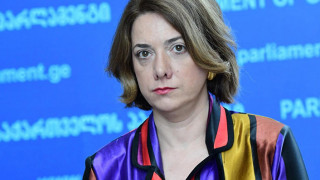Salome Samadashvili: “Perhaps we can hear an explanation as to how the Georgian Dream accomplished a sharply increased energy dependency on Russia.”
Verdict: FactCheck concludes that Salome Samadashvili’s statement is FALSE.
Analysis:
At the plenary session of the Parliament of Georgia, MP from Lelo, Salome Samadashvili asked a question to GNERC chairperson, Davit Narmania: “My question is about the major challenge this country faces – energy security. How is it that the Georgian accomplished a sharp increase in our country’s energy dependency on Russia in the course of the last years? Since 2014, electricity import has doubled and 60% of our electricity comes from Russia. Energy from Russia increased by 12% in one year alone.”
Hydro power plants (HPPs) constitute the major source of energy generation in Georgia. According to 2021’s data, the share of HPPs in the total energy generation was 80.5% followed by thermal power plants with 18.8% whilst wind energy generation is negligible and amounts to only 0.66%. In the reporting period (2014-2021), the total generation increased from 10.4 billion kwt/h to 12.6 billion kwt/h which is a 21.2% growth. Of additional note is that the Enguri and Vardnili HPP cascades account for 33.2% of the total generation (this is according to 2021’s data whilst the average figure of the previous years was 38.3%). In accordance with a verbal agreement, 40% of the generation of these HPPs is supplied to the Russian-occupied Abkhazia. Given the increased consumption in the past years, 40% is not enough and, in fact, the occupied territory receives a comparatively higher share energy generated by these HPPs which is 44.8% annually. Electricity consumption bears a seasonal character. At the same time, since nearly 80% of electricity generation comes from HPPs, electricity generation drops in winter and rises in warmer periods, simultaneously with increasing water resources owing to environmental conditions. Therefore, the country has a shortage of electricity in winter but a surplus in summer. Therefore, since it is impossible to accumulate electricity, Georgia sells electricity in warmer periods of the year (mostly to Turkey) and purchases electricity from Azerbaijan and Russia in colder periods. We take a look at statistical data in order to understand the extent to which Georgia depends on Russia in terms of electricity imports.
Table 1: Electricity Balance (Million Kwt/h)

Source: Energy Service Company
According to the Table 1, electricity import from Russia in nominal indicators has indeed doubled since 2014 as compared to 2021 and Russia’s share accounts for 62% of the total import. However, Russia’s share has shrunk by 15 percentage points as compared to 2014 because Russia’s share in the total electricity import was 77% in 2014. In addition, the share of Russian electricity import includes that energy which is supplied to Abkhazia. The Energy Service Company started to compile these statistics in 2019 and figures of the past years are as follows:
Table 2: Share Energy Supplied to Abkhazia in Russian Energy Import (Million Kwt/h)

Source: Energy Service Company
According to the data, the share of energy supplied to Abkhazia in energy imported from Russia has been rising in the past year. This indicates that the growth of electricity import from Russia is attributable to that fact. Therefore, if we deduct the volume of energy supplied to Abkhazia from the electricity imported from Russia it turns out that the share of import from Russia in the total import significantly declines and drops to 20% instead of 62%. However, since the Energy Service Company started to compile these statistics from 2019, we cannot make a comparison to 2014’s figure. It would be appropriate to measure the extent to which the share of energy imported from Russia has increased in the total energy consumption. In 2014, this figure was 5.7% whilst the same figure increased to 8.1% in 2021; that is, by 2.4 percentage points. However, there is a one-time significant factor behind this growth. In particular, from 20 January to 7 April 2021, the Enguri HPP was fully shut down for planned repair work. Since Abkhazia does not have an alternative source of energy, the total import of energy from Russia was carried out through the Georgian electricity system which technically caused an exaggeration of import from Russia. In regard to gas supply, Azerbaijan is major gas supplier for Georgia and Georgia receives gas for the social sector and TPPs for reduced prices in line with the contracts signed with Azerbaijan’s state oil and gas company (SOCAR) and the Shah-Deniz consortium. However, at the same time Georgia also buys Russian gas which the country receives from the North-South main gas pipeline. This pipeline transmits 2.2-2.3 billion cubic metres annually and is a major artery for Armenia’s gas supply. Prior to 2017, Georgia was receiving 10% of the total volume of natural gas as a transit fee a. Since 2018, Russia’s Gazprom Export pays a transit fee in a monetary form whilst the amount of payment is a commercial secret. The current demand for natural gas in Georgia has been within the margin of 2.2 billion cubic meters on average in the past few years whist there are some deviations from this average stipulated by climatic conditions or other factors. In regard to the market supply component, local extraction of natural gas is negligible and its share in the total consumption is around 0.3-0.4%. Therefore, Georgia depends on imported natural gas. Table 3 shows natural gas supply in terms of supplying countries.
Table 3: Natural Gas Supply in Georgia (Million Cubic Meters)

Source: Energy Service Company
According to the statistical data, the share of Russian gas in total import is marginal and has decreased from 11.7% to 7.9% over the past years. However, the Russian gas in the total import dropped by 1.7% whilst in 2019 and 2020 as compared to 2018 but increased again and reached 7.9% as mentioned earlier. It is unclear what Salome Samadashvili means by a 12% growth. If she compares 2020’s figure to 2019, then Russia’s gas import had a 26% growth as opposed to the 12% in her claim. In sum we may say that Georgia’s current energy sector dependence on Russia is not alarming. However, there has been a slight growth trend in the last years which is not desirable and more robust work is needed to reduce this dependency. Growth in energy imports in the past years has been attributable to increased energy consumption in Abkhazia in the past few years which the author of the statement disregards. In order to assess dependency on Russia, it is more appropriate to measure the share of Russian import in the total consumption rather than share of Russian import in the total import. In this case, there is a slight growth which is largely attributable to the scheduled shut down of the Enguri HPP for repair work. Therefore, a straightforward claim that dependency on Russia under the Georgian Dream has increased sharply is wrong.








